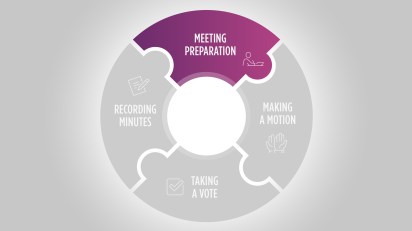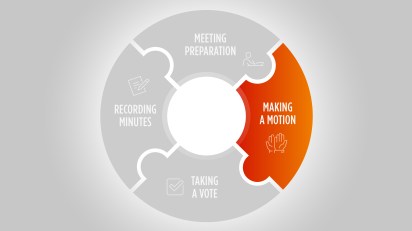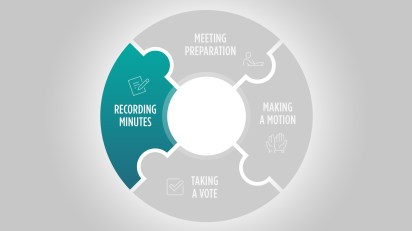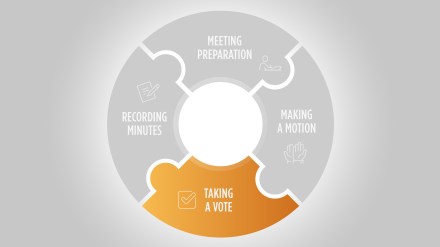Editor’s Note: Making every vote count in a church business meeting takes many forms. Continuing her look at effective business meetings through the hypothetical lens of Liz Jones, an experienced business administrator at First Church, Sarah E. Merkle illustrates the various types of votes that can be taken at a business meeting, and the methods for calculating their outcomes.
This four-part series is offered in support of Merkle’s “Mastering Meeting Basics.”
Before First Church’s annual business meeting, Liz Jones met with Terry Christensen, the church board’s chairwoman, to go over the four types of votes that can be conducted. The two looked closely at each option, weighing their benefits and drawbacks and assessing when they might prove most useful.
The homework pays off as the annual business meeting unfolds.
Vote Type 1: General or unanimous consent vote
“This type of vote is great for noncontroversial matters,” Jones told Christensen during their prep. “It also speeds up the meeting.”
The two agreed she’d use them for the first items on the agenda: adopting the agenda for this meeting and approving the last business meeting’s minutes. She followed that plan in the meeting’s first moments.
“First, we will approve the agenda for this meeting. Are there any objections to today’s agenda as presented?” she asks. Then, as Jones coached her, she pauses and counts to three. “Hearing no objection, the agenda is approved.”
Christensen clears her throat, then leans into the podium microphone again. “Next is approving the minutes from the last business meeting. Are there any corrections to the minutes as distributed?”
Three more seconds pass with silence. “Hearing no objection, the minutes are approved,” she says.
Jones told Christensen the likelihood of objections to either of these agenda items was very small. Had one arisen, though, she would have simply resorted to a voice vote.
Vote Type 2: Voice vote
Like Jones predicted, members discussed the proposed motion from the facilities committee with zeal.
A proposed amendment to that motion—in which bids would be sought for projects involving the church’s parking lot and HVAC system, but not for repainting the children’s ministry wing—went through lengthy discussion.
After nearly 20 minutes, Christensen senses it’s time to move things along. To do so requires a motion to close debate, followed by a second to that motion, then followed by approval by a two-thirds majority. With 300 members present, Christensen opts to use a voice vote.
“All of those in favor of closing the debate on the amended motion as presented, say ‘Aye.’”
The ‘aye’s’ boom across the room.
“All opposed, say ‘No.’”
Only a smattering of ‘no’s’ arises across the sanctuary. Christensen feels confident that two-thirds voted in favor.
Now it’s time to see if enough support exists to approve the motion as amended with the children’s ministry project removed.
This time, only a majority is needed. Christensen again opts for a voice vote.
“All of those in favor of the motion as amended, say ‘Aye.’” Christensen says.
Another hearty round of ‘aye’s’ fills the sanctuary.
“All opposed, say ‘No.’”
A strong number of ‘no’s’ spread across the sanctuary, too.
It’s too close to call.
Vote Type 3: Raised hand or standing vote
During the prep, Jones told Christensen about the usefulness of a “raised hand or standing vote” option. “You use this when a voice vote is too close to call. You can also use it if you need the exact vote count noted in the meeting’s minutes,” Jones explained. “It’s a really effective way to keep things moving when the vote itself doesn’t need to be kept in secret.”
With the voice vote on the parking lot and HVAC projects too close, and no apparent need for secrecy involved with either decision, Christensen chooses a standing vote.
“The chair was uncertain, so we’ll conduct a standing vote,” she says into the microphone. “All of those in favor, please stand.”
A large contingent of individuals across the sanctuary rise.
“Please sit down,” she says. “Now, all of those opposed, please stand.”
Another sizable group rises. It’s still too close to call, even visually.
Christensen asks those standing to sit. She then asks those in favor to stand again.
Two tellers attending the meeting to count votes then proceed to count off those who are standing. Upon finishing, Christensen asks supporters to sit, then asks those opposed to stand. The two tellers then have those who are opposed count off.
The result: Those in favor measured 102, while those opposed measured 101—the closest margin possible.
“The motion as amended passes,” Christensen says.
Vote Type 4: Ballot vote
Going into the annual business meeting, Jones knew the calling of an associate pastor would need a ballot vote. Not only is it a significant decision, and one that members may not wish to openly vote about, but the church’s bylaws require at least two-thirds of those present and voting to approve a decision like this.
A ballot vote ensures an accurate and official count is taken and documented with the meeting’s minutes.
Anticipating this, Jones worked ahead of time with Russ Moore, chair of the Associate Pastor Search Committee, to review the church’s membership roll.
She made certain enough notice was provided to all members about the expected vote during the meeting. And she made certain enough ballots were created and available on the day of the meeting.
Jones also ensured the ballots were printed with the actual question and appropriate responses for members to select. It didn’t have to be fancy—it just simply read, “I am in favor of calling Karl Miller to be associate pastor of First Church,” followed by boxes with “YES” and “NO” next to them. No signature was required since the bylaws didn’t require one and the desire for secrecy weighed heavily.
Counting votes
The ballots for Miller’s candidacy were collected. Two tellers quickly went through them.
Among the 300 members present at the meeting, 256 cast votes.
Jones recalled Sarah E. Merkle’s article on voting and the formula needed for determining at least a two-thirds majority. Here, since there were 256 members present who voted, the tellers would take 256, multiply it by 2, then divide it by 3 to determine the number of votes needed for a two-thirds approval. Since the mathematical result to this formula—170.6—wasn’t a whole number, the tellers rounded up to the nearest whole number, which is 171.
Tip: The formula for determining a two-thirds majority is (N x 2)/3 where N is the number of people present who voted. When the result is not a whole number, the number is rounded up to the nearest whole number.
For Miller, the members overwhelmingly approve his call by a margin of 243 to 13.
Christensen breathes a sigh of relief, partly because of the need to get Miller started soon, and partly because the controversy with the facilities projects earlier in the meeting was much closer—and almost didn’t pass.
Part of the reason why was because the calculation for a majority vote works differently from the formula for calculating a two-thirds vote. With a majority, the number of members voting is multiplied times 0.5. If a whole number results, then a 1 gets added. If a fractional number results, then it gets rounded up to the nearest whole number.
Tip: The formula for determining a majority vote is N x 0.5, where N is the number of people voting. If a whole number results, add 1. If a fractional number results, round up to the nearest whole number.
In the facilities motion as amended, 203 people voted. Multiplied by 0.5, the result was 101.5, and rounded up to the next whole number, the figure was 102. That meant the motion barely passed.
But it passed nonetheless, and as the meeting headed toward the home stretch, Christensen and Jones believed no major obstacles remained in the way. The church’s budget information was presented well in advance, and support already existed for the variance built in for the facilities projects.
Christensen and Jones were right: A voice vote on the approval of the budget overwhelmingly passed.
The meeting finished. Pastor Hayes considered it a major success.

Part 1 of 4: Prepping for a Church Meeting

Part 2 of 4: Managing Meeting Motions

